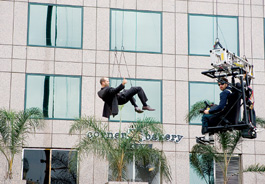home | metro silicon valley index | movies | current reviews | essay

Photograph by Ron Batzdorf
Up in the air: Jason Statham might as well be pixalated in 'Crank,' a big-screen video game.
A Cranky Film Future
Do today's hectic, ADD-driven features signal a genuine revolution in filmmakers' focus from people to objects?
By Richard von Busack
AFTER Crank made $16 million in one weekend, there were some who claimed that it was the movie of the future: the first successful synthesis of the video game with cinema. Starting with a vintage arcade-game title card, Crank raced its way to a breathless game-over. If it was different from the dozens of other cinematic adaptations of video games, it was only because there was no actual game that it sourced.
Crank's directors, Mark Neveldine and Brian Taylor, claimed that they knew their market: "We have ADD, and so do 70 million Americans." If you believe publicity, there's a new technological breakthrough in film every week, and Crank's claim to deliver the film of tomorrow didn't stand up to previous contenders, like that most frenzied piece of ADD cinema, Natural Born Killers. There, we had similar racial stereotyping (only more aggressive), similar cartoon violence (only more horrific) and a pounding sound mix of 70 songs (Crank had but a measly 20).
I saw Crank at a matinee with four silent obese men, who each staked out one-quarter of the theater, as if they each wanted one compass point of it. In the theater, the air of disappointment was as easy to smell as the odor of popcorn. There had been jubilant reviews on the Internet, such as this one from CHUD.com: "You know the first time you played Grand Theft Auto and shotgunned a guy's head off, and you laughed? That's Crank."
Who knows if this is a social problem, the growing fascination with not-real ammo hitting not-real characters? I hope to interview Ed Halter, who will be in San Francisco to discuss his book From Sun Tzu to Xbox: War and Video Games and the connections between U.S. military technology and games like America's Army, Battlezone and Conflict: Desert Storm.
I'm not ready to declare monkey see, monkey shoot, but what I do see is cinema changing to something else—some mix of film narrative, digital imagery and the video game.
Part of this transformation is the change of cinema's focus from humans to objects. Extensive product placement helped speed the way; once the camera lingered over James Bond's Aston Martin, but now the real stars of movies as different as Cars and The Fast and the Furious franchise are the automobiles themselves.
Since Clint Eastwood is too old, there might be a future in a spinoff film about the further adventures of Dirty Harry's .357 Magnum. Bullets get their own close-ups, anyway. The journey that began 100 years ago with the cowboy firing straight at the audience in The Great Train Robbery continues with today's (over)use of bullet-time animation. Now viewers can travel with a slug wherever it goes, blowing up an old lady's parakeet in Crank, entering someone's guts in Three Kings or enjoying a sizzling life of its own as it bores into a man's chest in Idlewild.
Philip Lopate's collection American Movie Critics includes a 1935 Rudolph Arnheim essay, "The Film Critic of Tomorrow," as well as a follow-up essay by J. Hoberman, written in 1998. Arnheim was pessimistic when he saw how the potential of silent film seemed to have come to a dead stop, broken down in creaky early sound film and the compromises involved in American movie studio cinema. Arnheim aims a rhetorical dagger at the heart of all critics and fans—and many directors. Arnheim denounces the critic who "lives from the glory of his memories like the 70-year-old ex-court actresses, rummages about as they do in yellowing photographs, speaks of names that are long gone; ... in the evening he sits with rapt attention in the cinema, a critical art lover, as though we still lived in the days of Griffith, Stroheim, Murnau and Eisenstein. He thinks he is seeing bad films instead of understanding that what he sees is no longer film at all."
The problem with understanding something like Crank or Jackass Number Two or the glut of political documentaries or the platforms for extreme acting like Half Nelson and Sherrybaby is just what Arnheim anticipated. Maybe what we're seeing isn't film at all. Maybe it's useless to hold it to the standards of what we know as film. Who wants to talk about the use of color or the cinematography in Half Nelson?
When a new technology comes around, there are two equal, opposite reactions. First, there are magnified claims for the power it will have—and we've heard that for a decade about how the digital camera is going to be a revolution. And then there's the second reaction: mourning for everything that the new app will sweep away.
Maybe neither response is really accurate, and a synthesis will come; can we expect a digital cinema that isn't about nervous frenzy, that doesn't look board-flat and have the kind of muddy, washed-out color that makes everyone look like a pale invalid or a painted corpse? Talents as different as Peter Jackson and Steven Soderbergh have worked past the limitations of synthetic film—the former by carefulness about color and texture in The Lord of the Rings series and King Kong, the latter by taking the trouble to light his sets precisely as in Bubble and to remember that space and time and breathing room are essential to cinema. In the meantime, everything exhibited in a movie theater is supposed to be a movie, when that's obviously not the case. The confusion of the audience continues; the times are as trying inside the theaters as they are outside of them.
Send a letter to the editor about this story.
|
|
|
|
|
|